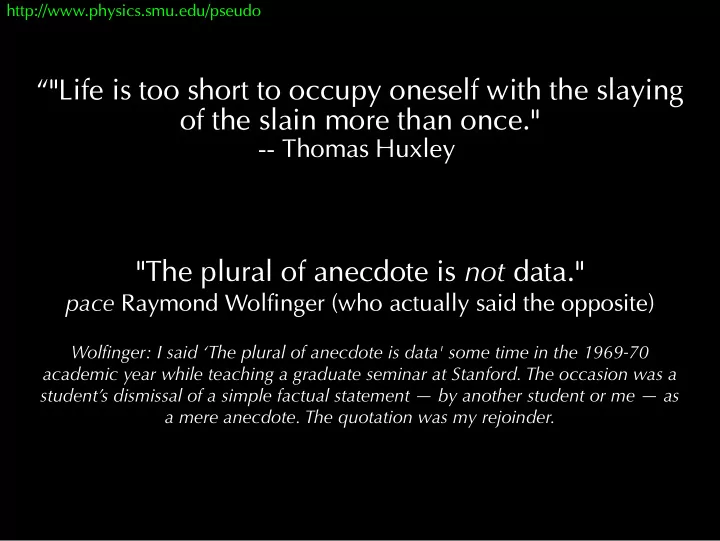

http://www.physics.smu.edu/pseudo “"Life is too short to occupy oneself with the slaying of the slain more than once." -- Thomas Huxley "The plural of anecdote is not data." pace Raymond Wolfinger (who actually said the opposite) Wolfnger: I said ‘The plural of anecdote is data' some time in the 1969-70 academic year while teaching a graduate seminar at Stanford. The occasion was a student’s dismissal of a simple factual statement — by another student or me — as a mere anecdote. The quotation was my rejoinder.
http://www.physics.smu.edu/pseudo What is Evidence? (Science, Pseudoscience and Evidence) Supplementary Material for CFB3333/PHY3333 Professors John Cotton and Stephen Sekula February 13, 2012 Based on the following information on the web: http://www.physics.smu.edu/pseudo/Pscience
http://www.physics.smu.edu/pseudo Reviewing the Examples ● UFOs ● lesson: just because you cannot explain an observation with all known hypotheses doesn't allow you to jump to extreme conclusions – e.g. a UFO cannot be explained by aircraft, satellites, astronomical phenomena, or hallucination; it must be aliens! ● Roswell and The Bermuda Triangle ● lesson: look for the primary sources behind a “good story” – e.g. how can one test the validity of the details of a story (shipping records, weather reports, dates, times, people involved, statistics)? – direct appeal to primary sources of information is critical
http://www.physics.smu.edu/pseudo The Scientific Method A Brief Review ● Observation of a phenomenon ● what kind of observations? ● how reliable are the observations? ● Formulation of an hypothesis ● how does one begin to form a causal explanation for the phenomenon? ● what evidence is used to generate the hypothesis? ● how reliable is the evidence? ● Performance of experiment ● what means are available for testing different properties or ideas? ● how does one setup a reliable experiment? ● how does one gather information from the experiment?
http://www.physics.smu.edu/pseudo The Scientific Method A Brief Review ● Observation of a phenomenon ● what kind of observations? ● how reliable are the observations? ● Formulation of an hypothesis ● how does one begin to form a causal explanation for the phenomenon? ● what evidence is used to generate the hypothesis? ● how reliable is the evidence? ● Performance of experiment ● what means are available for testing different properties or ideas? ● how does one setup a reliable experiment? ● how does one gather information from the experiment?
http://www.physics.smu.edu/pseudo What is Pseudoscience? ● Definition: ● Something that claims to be scientifjc, but is not. ● How do you spot it? ● Pseudoscience is EVERYWHERE ● The best way to spot it (not always a simple thing!) is to compare the practices involved in something claimed to be “scientific” with the actual standards and practices of science – compare their method to the REAL scientific method
http://www.physics.smu.edu/pseudo Encapsulated Scientific Method ● Remember: ● Observe a phenomenon ● Develop an hypothesis for it (a possible explanation) ● Use the hypothesis to predict other phenomena ● Check the prediction by observation or experiment ● A process that requires CREATIVE THINKING ● Induction: using all previous scientific training to formulate the hypothesis ● Deduction: using the new hypothesis to generate a prediction
http://www.physics.smu.edu/pseudo QUESTION: Can the scientific process ALWAYS work this way? What are some examples where it's not possible to exactly follow these steps?
http://www.physics.smu.edu/pseudo Some guidelines for when you can't follow the prescription EXACTLY ● From Schick and Vaughn: “ . . . any procedure that serves systematically to eliminate reasonable grounds for doubt can be considered scientific.” ● From skeptic Michael Shermer: “Scientific progress is the cumulative growth of a system of knowledge over time, in which useful features are retained and nonuseful features are abandoned, based on the rejection or confirmation of testable knowledge.”
http://www.physics.smu.edu/pseudo So . . . what is Pseudoscience? ● Quick and dirty rule-of-thumb: ● Pseudoscience is any procedure that ignores one or more of the steps ● But it SOUNDS like science...! ● Pseudoscience is crafty – it uses a lot of scientific-sounding language ● When you get past the words and know how to look closely, you'll see that they don't respect the METHOD. – e.g. objective evidence is ignored or lacking ● Real science is a process, not a result. The process matters more than the outcome.
http://www.physics.smu.edu/pseudo Pseudoscience is identifiable http://www.physics.smu.edu/pseudo/Pscience/science-pseudoscience.pdf
http://www.physics.smu.edu/pseudo
http://www.physics.smu.edu/pseudo
http://www.physics.smu.edu/pseudo Look at the list of forms of bad and good evidence available here: http://www.physics.smu.edu/pseudo/Pscience/
http://www.physics.smu.edu/pseudo Testimonials and Anecdotes
http://www.physics.smu.edu/pseudo HAIRBLAST! (patent pending) BEFORE HAIRBLAST AFTER HAIRBLAST (I kan haz none date!) (Alice iz in Wonderland!)
http://www.physics.smu.edu/pseudo Photographs
http://www.physics.smu.edu/pseudo The UFO!
http://www.physics.smu.edu/pseudo The IFO (?!)
http://www.physics.smu.edu/pseudo The Perpetrator!
http://www.physics.smu.edu/pseudo The Perpetrator!
Recommend
More recommend